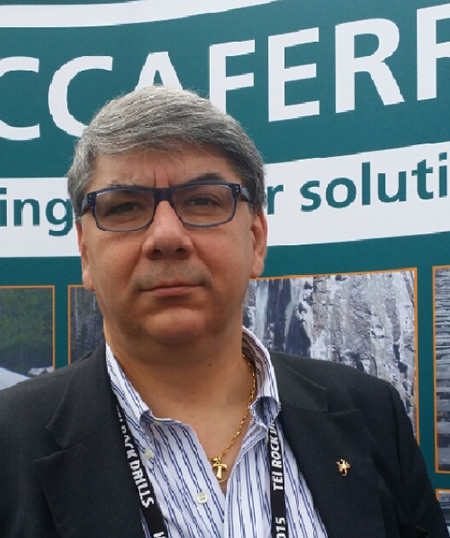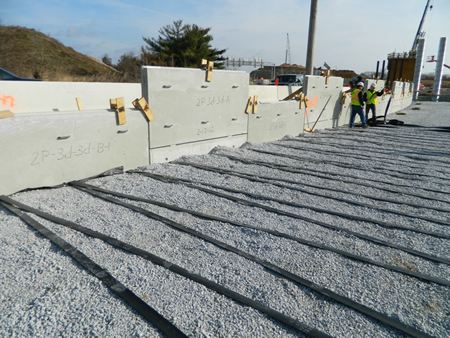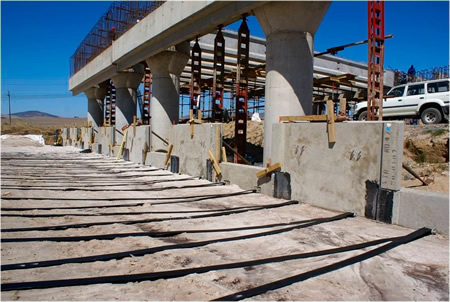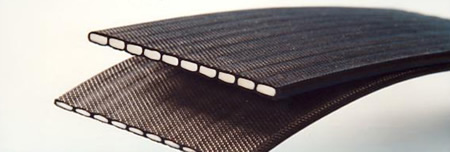



The Transportation Research Board (TRB) Annual Meeting honored the paper “Instrumented MSE Wall Reinforced with Polyester Straps” (Paper #15-0895) with its Best Paper 2015 award from TRB’s Soil Mechanics Section. The work, which was sponsored by TRB committee AFS10 Transportation Earthworks, was co-authored by Yushan Luo, Dov Leshchinsky, Pietro Rimoldi, Giulia Lugli, and Chao Xu. Geosynthetica interviewed Maccaferri’s Moreno Scotto (Maccaferri USA President and Corporate Manager of the Geosynthetics Business Unit of the Maccaferri Group) about the increasing use of polymeric strap reinforcement in MSE designs. Scotto’s colleagues Pietro Rimoldi (Geosynthetic Specialist of the Geosynthetics Business Unit for the Asian market) and Giulia Lugli (MacRes specialist in the Maccaferri USA subsidiary) were co-authors on the award-winning paper.
**
The TRB award is quite an honor. How did Maccaferri come to be involved in the field project (Interstate 95 interchange MSE walls in Christiana, Delaware)?
It’s really an honor but mostly because it recognizes all the work done and the faith we had in promoting and introducing this system into this market.
We introduced polymeric reinforcements into the United States several years ago. The full range of reinforcement materials, including the geostrips used for this specific wall, have been available through the NTPEP program since 2010. The strips are simply the latest step here, but these reinforcement materials have been supplied for vertical panel reinforced soil wall systems all over the world. The main markets for these solutions has historically been in the Middle East, India and Europe.
When this project came about, the Delaware Department of Transportation was interested in evaluating polymeric strip reinforcement solution for these types of walls. DelDOT authorized the use of them in the construction of 16 MSE walls and 12 bridge abutments on the Interstate 95 work in Christiana. To ensure certainty in the design and validate future use, they required that monitoring equipment was incorporated into the structure. Maccaferri USA, under the supervision of Prof. Dov Leshchinsky and supported by its Italy-based head office, monitored the performance data from which reports were generated.
What were the chief reasons for using polyester strap reinforcements for the MSE construction?
The original project was based on a steel strip reinforcement system. The use of polymeric strips in place of metallic ones was part of a value engineering proposal. Two main aspects were emphasized:
- Increase in the design life of the wall: the original design was based on a 75-year design life but was upgraded to 100 years
- Reduced project costs: the polymeric system provided the State interesting savings
Of these, the increased design life was especially important—another reason DelDOT wanted to use instrumentation to study the wall. A two-year-minimum monitoring period was requested, with the contractor/supplier being asked to cover the costs. Maccaferri took the technical leadership for managing this step.
This isn’t the only wall of this sort that your company has been involved with. Can you summarize the key projects and data we have to draw upon now?
First, as far as I know, nothing similar to this has been done in the United States. This is, we believe, the first wall with this technology to be fully instrumented with data being made available to the engineering community. It isn’t the only notable construction, though.
Our company has built another full-scale structure in Brazil (approx. 20 feet) and has instrumented it too. In that case, half of it was reinforced with steel and the other half with the polymeric strip material, Paraweb®. The esteemed Prof. Michele Magueri, who recently passed away, led the analysis of the work in Brazil with our colleagues there, regarding the behavior of the two sides of the wall. Those results will also be published soon, and they will confirm the validity of the polymeric solution and this design approach.
Also, it needs to be noted that the first instrumented wall with Paraweb® was actually built in 1974—more than 40 years ago!— by TRRL, the UK-based Transport Research Laboratory. That wall is still performing well. Every five years, we exhume a piece of polymeric reinforcement and test it. These data have been published in various conferences and are available. Like whisky, if I may use a humorous example, the tests show that the polymeric reinforcement straps seem to have gotten better with age. The truth is that testing equipment is much more efficient and sophisticated, so the data is clearer and more finite; but, it is also true that the Paraweb® continues to perform strongly.
If you consider all this mass of information that we make constantly available for the engineering community as soon as it is “ready to go”, I believe that we are giving – and we will continue in the future too – a massive contribution to the technical and the engineering expertise to grow confidence in these new technologies; embodied in the spirit of our Corporate motto … “Engineering a better Solution”.
Extensible reinforcements with polymeric components have been used in MSE walls since the 1970s, but strap reinforcements of this nature seem to have been somewhat overlooked until fairly recently. What about current manufacturing or project needs and economics have helped elevate strap reinforcements in geotechnical design?
This is very new for the American market, but not outside the US. We have huge structures reinforced with the same polymeric reinforcement strategy going back to the 1980s in the Middle East, India, Africa and extensively within Europe. Furthermore, the specific reinforcement, Paraweb®, has long been a component of the MacRes® System (a vertical concrete panel reinforced soil wall system), and the Freyssisol System. Both systems are BBA certified. The polymeric strip reinforcement offers a lot of benefits, like great resistance, excellent stiffness, and long-term durability. Paraweb® even has a 120-year certified design life. It’s highly resistant to chemical attack and installation damage due to its tough LLDPE protective coating. It’s less expensive, especially for high walls because instead of using more and more of the same strength strip on each concrete panel, fewer higher strength polymer strips – 30 kN to 150 kN, in this case—can be used. Last, but not least, this solution is less restrictive on the properties of the fill material. These are seen as the primary advantages of geosynthetic geostrip reinforcement over steel strips, which are the main competitor to this type of approach.
How does working with polymeric strap reinforcement differ from geogrids?
Well, strips are a linear reinforcement while grids are a distributed one; if we want to increase the strength when we design with a “grid” we have to increase the grid strength while with the strips we have either the option to increase the strip strength or to increase the number of strips. That flexibility enables us to manage the cost and optimize the design. Generally speaking, in the upper part of the walls the design is regulated by the pull-out resistance of the strip, whereas it is the strength criteria which rule the design in the lower portions of the wall. The strength criteria applicable to Paraweb® are exactly the same as for any geogrid; creep, installation damage, durability, and so forth. For the NTPEP program, the product was tested in the same way as geogrids, but in terms of pull-out performance the Paraweb® is higher and its bond coefficient is higher than 1, while for geogrids it is typically below 1. (AASHTO suggests 0.67.)
Paraweb®, though, is ultimately more comparable to a metallic strip than to a geogrid. The main difference between these two reinforcement materials—other than the benefits noted earlier—is the fact that polymeric strips are extensible (by definition) while steel is not. However, considering that the Paraweb post-construction creep deformation is always below 1% (one) and that reducing the rate of UTS taken into account in the calculations, this deformation is reduced to very small values. Consequently, Paraweb can be considered as behaving as an inextensible reinforcement.
In the USA, however, this material is new, so we are not adopting the typical design criteria (above); we consider and design it as an extensible material —the same design criteria as a polymeric geogrid—but in the rest of the world, these solutions have essentially been designed, with great success, as inextensible reinforcement.
Beyond that, the polymeric strip reinforcement approach for vertical walls, with its connection and the installation procedures, are just quicker and easier to install, which further enhances the cost advantages on projects. We’re hopeful and confident the US market will adopt this approach more widely soon.
**
We thank Mr. Moreno Scotto for his time and Maccaferri for sharing its insight. For more information on these reinforcement systems, visit www.maccaferri.com.











